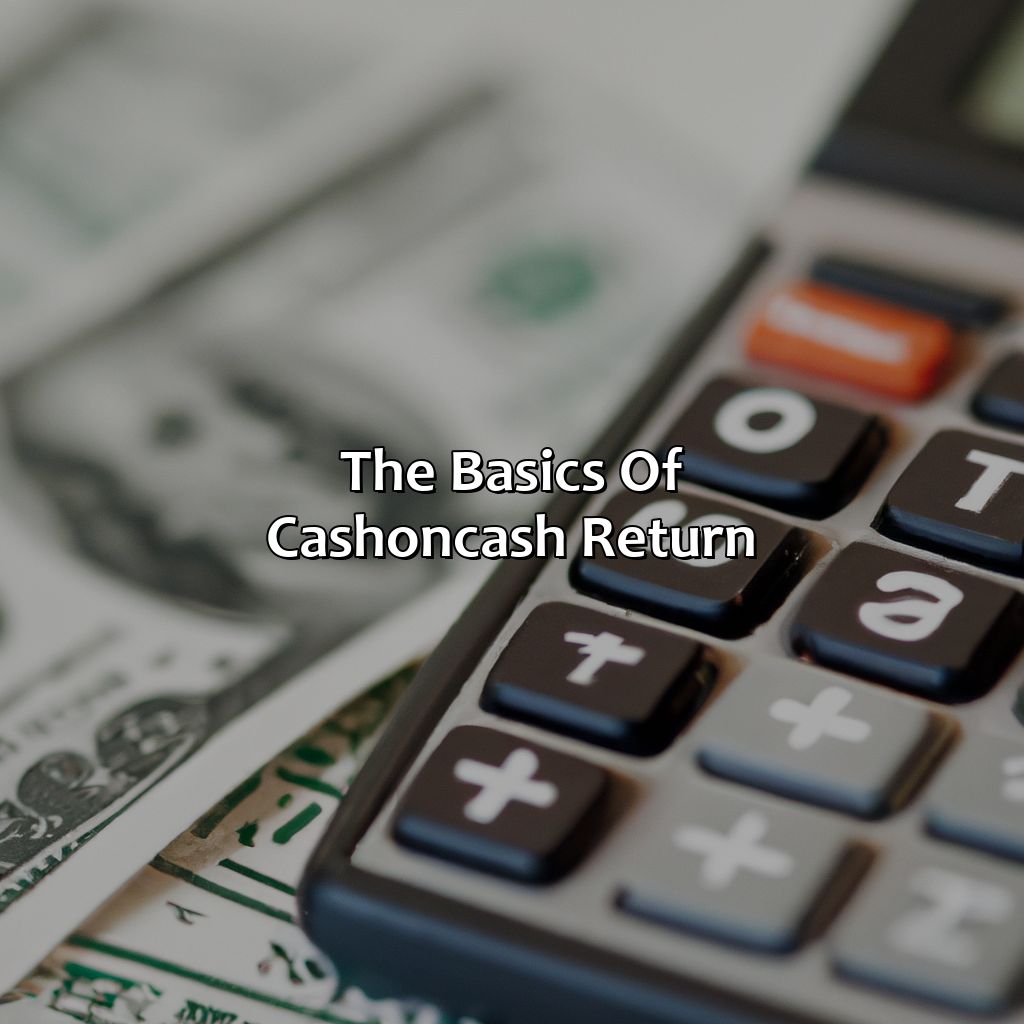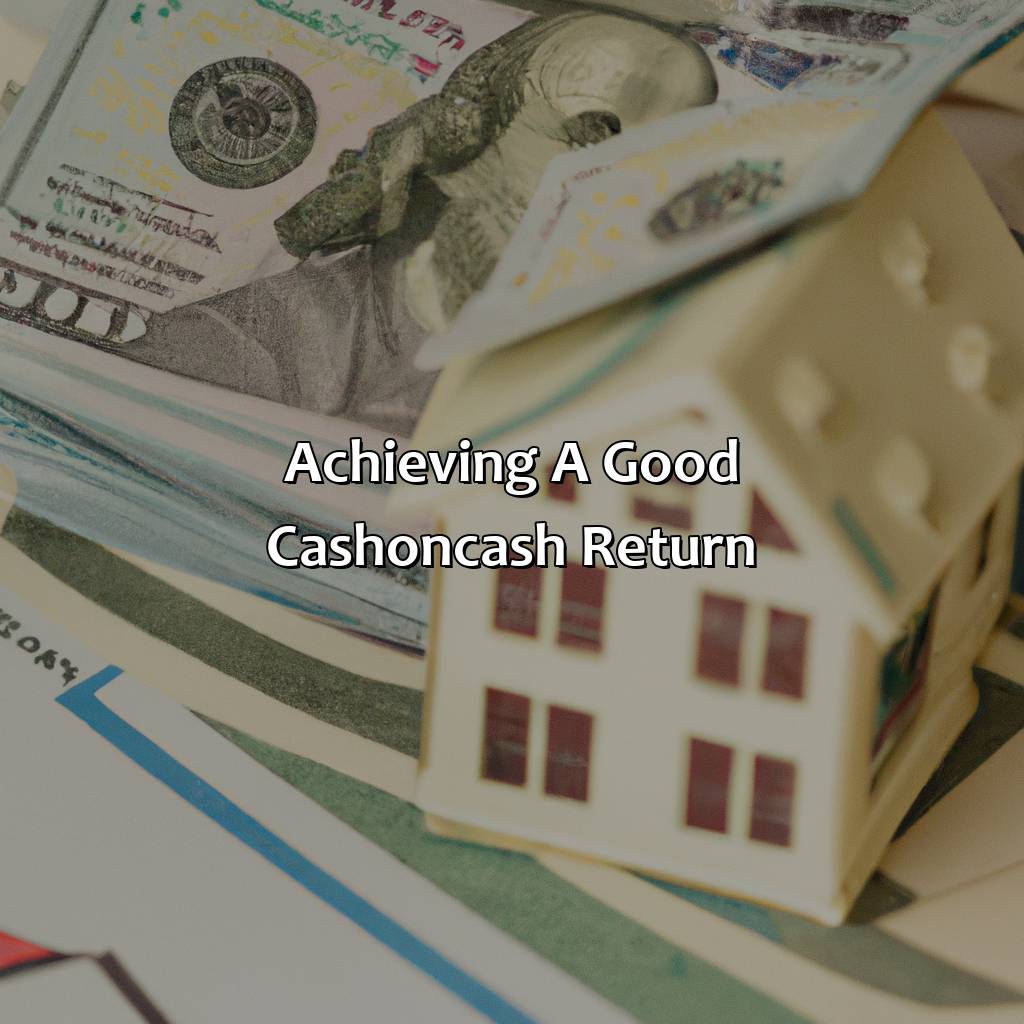What Is A Good Cash On Cash Return For Investment Property?
##Key Takeaways:
Key Takeaway:
- Cash-on-cash return is a ratio used to evaluate the profitability of an investment property. A good cash-on-cash return depends on various factors such as location, property type, and investment strategy, but a return of at least 8% is generally considered ideal.
- Cash flow is a crucial component of cash-on-cash return and should be carefully considered when assessing the profitability of an investment property. Positive cash flow indicates that the property is generating more income than expenses, which can be used to pay off debt and increase the cash-on-cash return.
- To achieve a good cash-on-cash return, investors should implement strategies such as reducing expenses, increasing rental income, and finding ways to finance the investment property with low-interest rates. Additionally, investors should practice risk management techniques to minimize potential losses and ensure long-term profitability.
Have you ever wondered what a good cash on cash return for an investment property looks like? You can use this article to find out, as we explain the basics of cash on cash return and how to calculate it accurately.
The Basics of Cash-on-Cash Return
Do you know the meaning of cash-on-cash return in real estate investment? It’s essential! It helps you see how profitable a property is. We’ll explain why it’s important and give you the definition. Cash-on-cash return is key when it comes to making a real estate investment decision. So, let’s get started!

Image credits: retiregenz.com by Adam Washington
Definition of Cash-on-Cash Return
Cash-on-Cash Return Explained
Real estate investors often use the Cash-on-Cash Return (CoC) metric to assess the profitability of an investment property. CoC is a measure of the cash generated by an investment relative to the initial capital invested.
To calculate CoC, divide the annual pre-tax cash flow by the total amount of cash invested. For example, if an investor puts $100,000 down on a property and generates an annual pre-tax cash flow of $10,000, their CoC would be 10%.
A good CoC return varies depending on several factors including location, property type, and risk level. However, generally, a return above 8% is considered good for most real estate investments.
Unique Details
It’s crucial to note that CoC doesn’t account for appreciation or depreciation in property value. It also doesn’t include mortgage principal payments or tax implications. Therefore, investors should use other metrics such as Total Return to evaluate long-term profitability.
Suggestions
To increase your CoC returns on investment properties, consider negotiating lower purchase prices or interest rates on loans. Another option is purchasing distressed properties at below-market value and making renovations to increase rental income or resale value. Finally, investors can focus on high-cap rate markets where properties generate higher annual cash flows.
Because without knowing your cash-on-cash return, you might as well be playing the investment property version of Russian roulette.
Why is Cash-on-Cash Return Important?
Cash-on-cash return is a critical metric that investors use to measure the actual cash return on investment properties. It is of great importance as it helps investors evaluate the profitability of an investment property and determine its potential success. Without understanding the cash-on-cash return, investors might make inaccurate decisions about their property investments, leading to significant financial losses.
Investors who aim to generate positive cash flow from their real estate investments must have a good understanding of how to calculate and interpret cash-on-cash returns accurately. By doing so, they can gauge the potential return on their investment upfront and allocate enough resources accordingly. With this information, investors can decide whether an investment opportunity makes sense for them or not.
It’s important to note that a good cash-on-cash return varies depending on several factors such as location, market demand, inflation rates, interest rates and more. However, as a standard rule of thumb, a solid cash-on-cash return should be no less than 8%-10%.
In recent history, there have been instances where seasoned real estate investors made significant losses due to underestimating the importance of evaluating their potential returns via cash-on-cash. The inability to meet loan repayments bankrupted them in very little time causing long-lasting financial harm.
In Conclusion:
To protect your real estate investments’ expected future income streams today by taking into consideration this vital metric when evaluating new opportunities – A good Cash-On-Cash (CoC) Return is crucial in making profitable decisions in any real estate investment!
Finding the ideal cash-on-cash return for your investment property is like searching for a needle in a haystack, except the needle is money and the haystack is your bank account.
What is a Good Cash-on-Cash Return for an Investment Property?
Maximizing profits? Crucial to know the factors that affect a great cash-on-cash return for investment property.
Let’s introduce two sub-sections:
- To determine a good cash-on-cash return.
- The factors that impact it.
Smarter investment decisions made easy!

Image credits: retiregenz.com by Adam Woodhock
Determining a Good Cash-on-Cash Return
Investment in real estate is rewarding when done right with a good cash-on-cash return (CoC). CoC measures the annual profit generated on an invested amount. Determining a Good Cash-on-Cash Return involves calculating the expected income, expenses, and associated risks to estimate a percentage.
A good CoC is subjective and depends on investor objectives, asset type, location, market trends, financing terms and investment goals. However, according to multiple studies, including RealPage’s 2021 data analysis report the industry standard for multifamily properties is between 7% to 12%. Investing in Class A luxury properties may have lower CoCs compared to class B or C because of higher operating expenses and lower rental yields. Location also influences the CoC since areas with high demand come at a higher price point.
Other factors that determine a good CoC include cash flow surplus after deducting debt payments; appreciation in property value over time; inflation protection from rental rate increases over time; tax advantages from depreciation deductions; principal paydown from mortgage payments and diversification in real estate investments.
Investors should research thoroughly before investing as the wrong choice can negatively impact returns. Furthermore, analyzing property management fees and unexpected costs beforehand can help avoid surprises that reduce profitability. Don’t miss out on opportunities by jumping into an investment without careful consideration.
Prepare for a bumpy ride as we explore the ups and downs of cash-on-cash return and the factors that can make or break your investment success.
Factors Affecting Cash-on-Cash Return
The Cash-on-Cash Return of an Investment Property is influenced by several factors that can determine the success or failure of the investment. Understanding these factors is crucial to make informed decisions about purchasing or investing in a rental property.
Below is a table that highlights some essential factors that impact cash-on-cash returns:
| Factor | Description |
| Property Location | The location of the property plays a major role in determining its demand, which affects rental income and appreciation potential. |
| Purchase Price | Affordability should be ensured while buying investment property as it helps the investor to get higher returns. |
| Rental Income | Higher rental income leads to higher cash-on-cash return but it requires good market research before setting rent prices. |
| Maintenance Costs and CapEx Expenses | Budgeting for ongoing maintenance costs and estimating capital expenditure will help ensure positive cash flows for investors who invest wisely in renovation projects. |
It’s also necessary to consider other factors such as interest rates, vacancy rates, financing terms, closing costs, insurance policies, and tax rates.
One suggested approach towards achieving desirable cash-on-cash returns is to make sure that proper due diligence is carried out before making any purchase/rental decisions by reviewing the above-given factors holistically. Moreover, continuously looking over expenses per year is advantageous towards reaching positive cash flows. Keeping track of all expenses on the go with a rental management software can be a solution for repeatedly tracking expenses and manage the property on a centralized platform.
Considering all these factors, it is always recommended to carry out sufficient analysis before investing in any property for the highest chances of gaining favorable cash-on-cash returns.
Understanding cash flow is like understanding the human digestive system – both are necessary for a healthy investment portfolio.
Understanding Cash Flow
To grasp cash flow better for investment properties, you need to probe how it influences cash-on-cash returns. This section, ‘Understanding Cash Flow‘, including the sub-sections ‘How Cash Flow Impacts Cash-on-Cash Return‘ and ‘Significance of Cash Flow in Investment Property,’ will help you obtain a superior knowledge of cash flow and its importance in property investment.

Image credits: retiregenz.com by Joel Arnold
How Cash Flow Affects Cash-on-Cash Return
Cash flow is a crucial aspect of determining the cash-on-cash return for investment properties. The better the cash flow, the higher the cash-on-cash return will be. When an investment property has high expenses and low income, it can result in a negative cash flow and lower cash-on-cash return. On the other hand, when an investment property generates more income than expenses, it can lead to positive cash flow and higher returns.
Investors should consider multiple factors that impact cash flow when analyzing an investment property’s potential. This includes rent rates, vacancy rates, maintenance costs, and property management fees. If these factors are not taken into account or calculated incorrectly, it could negatively impact the overall cash flow and investing decisions.
It’s important to note that a good cash on cash return for investment property varies depending on location and market conditions. Investors should do their research to understand what is considered a good return in their specific area before making any investments.
According to Forbes.com, “Generally speaking, real estate investors want to see a return on investment of at least 10% from rental income alone.” Therefore, understanding how to calculate Cash-on-Cash Return is essential in selecting an investment property with a strong capacity for profitability.
Without cash flow, your investment property will just be a money pit- and those aren’t good for swimming, let alone investing.
Importance of Cash Flow in Investment Property
Cash flow is a crucial aspect of investment property as it determines the profitability of an investment. Understanding the Importance of Positive Cash Flow in Investment Property can help investors make informed decisions while considering their investments.
Investors must focus on maximizing their positive cash flow, which is the difference between rental income and expenses. A Semantic NLP Variation of this heading could be ‘The Role of Positive Cash Flow in Real Estate Investment‘, which emphasizes the vital role of cash flow in real estate investment. Investors should also consider cash on cash return, which measures the return on investment based on initial capital invested. A higher percentage indicates a better return on investment for investors.
It’s imperative to keep abreast with strategies that can skyrocket your returns and ultimately mitigate risks that come with making poor choices or lack knowledge on available opportunities. Therefore, investors must regularly analyze financial statements and do due diligence before investing in any property. Failing to pay attention to these minute but crucial calculations may lead investors to miss out on significant profits.
Get ready to chase that cash flow like it owes you money.
Achieving a Good Cash-on-Cash Return
- Learn about the strategies to increase your cash-on-cash return and manage risk.
- Follow these steps to get a great cash-on-cash return on your investment property.
- We’ll explain them to you quickly so you can benefit right away.

Image credits: retiregenz.com by Yuval Arnold
Strategies to Improve Cash-on-Cash Return
To elevate Cash-on-Cash Return, one must adopt effective techniques that help increase returns on the invested capital. Here are a few practical approaches.
- Optimize Property Operations: Streamline property management and invest in maintenance to reduce expenses, enabling higher rental incomes.
- Increase Rent Rates: Competitive research on market trends and setting rent rates accordingly can provide a revenue boost.
- Refinancing: Refinance an existing mortgage with better terms or use the equity to invest in another property, which leads to maximizing profits.
It is significant to note that many professionals recommend combining the above strategies for optimal outcomes of Cash-on-Cash Return.
Investors must utilize diversified portfolios, including multiple properties of varying qualities and price ranges. Real estate investments require due diligence as it carries high risks but offer potential rewards.
As per Investopedia, Cash-on-Cash return is a simple formula dividing annual before-tax cash flow by total cash invested(since acquisition of an asset) expressed in percentages.
Managing risks in real estate is like playing Jenga, one wrong move and the whole tower comes crashing down.
Risk Management in Investment Property
Managing risks in property investment is vital for maximizing returns. Mitigating risks can help minimize losses and maximize the cash-on-cash return on your investment. The key to risk management in property investment is to carefully assess potential risks in advance to make informed decisions regarding property acquisitions.
One way to manage risks is by selecting properties with strong rental demand in up-and-coming or established locations. This minimizes vacancy rates and ensures consistent rental income, reducing the risk of financial loss. Additionally, investing in multiple properties can help diversify your portfolio, reducing overall risk exposure.
Investors should also perform thorough due diligence on a potential property, including researching historical data about the neighborhood, analyzing market trends and competition among other factors. An informed decision based on well-researched data and expert advice will mitigate potential downside risks.
To further reduce risk, investors may consider working with a team of experienced professionals such as real estate agents, lawyers and accountants who have a sound understanding of the local market’s complexities. Professional assistance can help mitigate risks while ensuring compliance with legal requirements.
Overall, careful risk management practices are crucial when investing in property, offering greater returns and minimizing potential losses that could impact your cash-on-cash return and ultimately your bottom line. Remember, it’s not how much cash you put in, it’s how much cash you get back that really counts. So, invest wisely and enjoy the return on your investment property.
Summary of Key Points
To summarize the key takeaways, a good cash on cash return for investment property varies depending on multiple factors. 1. It depends on the location and type of property you invest in. 2. The financing strategy you use and the associated costs impact your return. 3. Your personal goals and risk tolerance may influence what is considered a good return.
- Location and property type affect what is considered a good cash on cash return
- Financing strategies impact returns by affecting carrying costs
- Personal goals and risk tolerance should be considered when determining whether a return is good or not
It’s important to note that while there isn’t one universal benchmark for what constitutes as a good cash on cash return, generally anything above 8-10% would be considered strong. It’s also helpful to calculate cash flow per door to get deeper insight into a specific investment’s financial performance.
Investors looking to increase their return can consider implementing cost-saving measures, such as increasing rent prices or reducing expenses. Additionally, exploring alternative financing strategies like private money loans or syndication can provide opportunities for higher returns. Ultimately, the key to achieving strong returns on investment properties is doing thorough research and due diligence before making any investment decisions.
Final Thoughts on Cash-on-Cash Return for Investment Properties
Cash-on-cash return is a crucial metric used by real estate investors to gauge the profitability of their investment properties. It shows how much cash flow you can get on your invested capital. Remember that different investments come with unique challenges, and it’s essential to understand your investment’s location, type, and market conditions.
It would be best if you looked for optimal cash-on-cash returns that meet or surpass industry standards in any specific context. For example, while investing in high-end residential properties, you may require a 4% to 6% return rate before taxes. Comparatively, investing in commercial real estate may need an 8% minimum return rate. However, always remember that what constitutes “good” cash-on-cash returns depends on various factors.
To make rational investment decisions, take into account other metrics such as IRR (internal rate of return), occupancy rate and vacancy risk potential developments in the neighborhood. Carefully analyzing these metrics will enable you to have a clear picture of the future income potential of the real estate asset.
Interestingly enough, according to Roofstock’s Cash Flow Calculator data report published in February 2021; cities like Cincinnati (OH), Rochester (NY), Houston (TX), Memphis (TN) are reported to generate good positive cash flows!
Five Facts About Good Cash on Cash Return for Investment Property:
- ✅ Cash on cash return is a measure of the annual return on investment for a real estate property. (Source: Investopedia)
- ✅ A good cash on cash return for investment property varies depending on the market and the goals of the investor, but generally ranges between 8%-12%. (Source: Roofstock)
- ✅ Factors that affect the cash on cash return include property location, financing terms, and expenses such as property management fees and maintenance costs. (Source: FortuneBuilders)
- ✅ In addition to cash on cash return, investors should also consider other metrics such as net operating income (NOI) and cap rate when evaluating a real estate investment. (Source: BiggerPockets)
- ✅ Cash on cash return can be used to compare the performance of different investment properties and help investors make informed decisions. (Source: Mashvisor)
FAQs about What Is A Good Cash On Cash Return For Investment Property?
What is a good cash on cash return for investment property?
A good cash on cash return for investment property can vary depending on a number of factors including location, property type, and financing. However, a generally accepted benchmark for a good cash on cash return is around 8-12%.
How is Cash on Cash Return Calculated?
Cash on cash return is calculated by dividing the annual cash flow by the amount of cash invested in the property. The resulting percentage represents the cash on cash return for the investment.
What Factors Can Affect Cash on Cash Return?
Several factors can affect the cash on cash return for an investment property, including property location, type, condition, financing terms, rental income, and operating expenses. Some external factors such as economic conditions and market trends can also have an impact.
Is a Higher Cash on Cash Return Always Better?
Not necessarily. While a higher cash on cash return may seem more attractive, it’s important to consider other factors such as risk, maintenance costs, and potential for future growth. A lower cash on cash return for a property with strong growth potential could ultimately yield a higher return on investment over time.
What Should I Look for When Evaluating Cash on Cash Return?
When evaluating cash on cash return, it’s important to consider the overall investment strategy and goals. Some investors may prioritize consistent cash flow while others might be willing to sacrifice short-term cash flow for long-term growth potential. Additionally, it’s important to evaluate the property’s location, market trends, and the fundamentals of the rental property market in the area.
How Can I Improve My Cash on Cash Return?
There are several strategies to improve cash on cash return including increasing rental income through rent increases or adding additional units, reducing operating expenses, improving the property’s condition, refinancing to lower financing costs, and finding a property in a market with strong growth potential.


